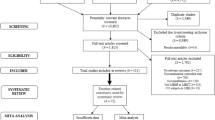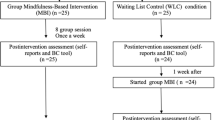Abstract
The Applied Mindfulness Process Scale (AMPS) is a measure that assesses the use of mindfulness skills in daily life. The scale is ideally used during or after a mindfulness-based intervention. It consists of 15 items that can be rated on a five-point Likert scale and measures three different domains, namely, decentering, positive emotion regulation, and negative emotion regulation. The AMPS was developed and validated using qualitative and quantitative techniques. It exhibits excellent reliability and nomological validity, correlating positively with well-being scales and negatively with measures of distress. Moreover, it has incremental validity accounting for variance in outcome measures beyond the explanatory power of other mindfulness measures. Preliminary research findings indicate that the scale is sensitive to changes in mindfulness. However, the AMPS is a relatively new scale, and more research is needed that uses the scale in mindfulness-based intervention research.
Similar content being viewed by others
References
Baer, R. A., Smith, G. T., & Allen, K. B. (2004). Assessment of mindfulness by self-report: The Kentucky inventory of mindfulness skills. Assessment, 11(3), 191–206. https://doi.org/10.1177/1073191104268029
Baer, R. A., Smith, G. T., Hopkins, J., Krietemeyer, J., & Toney, L. (2006). Using self-report assessment methods to explore facets of mindfulness. Assessment, 13(1), 27–45. https://doi.org/10.1177/1073191105283504
Black, D. S., Sussman, S., Johnson, C. A., & Milam, J. (2012). Psychometric assessment of the Mindful Attention Awareness Scale (MAAS) among Chinese adolescents. Assessment, 19(1), 42–52. https://doi.org/10.1177/1073191111415365
Bloch, R., & Norman, G. (2012). Generalizability theory for the perplexed: A practical introduction and guide: AMEE guide no. 68. Medical Teacher, 34(11), 960–992. https://doi.org/10.3109/0142159X.2012.703791
Britton, W. B., Lindahl, J. R., Cahn, B. R., Davis, J. H., & Goldman, R. E. (2014). Awakening is not a metaphor: The effects of Buddhist meditation practices on basic wakefulness. Annals of the New York Academy of Sciences, 1307(1), 64–81. https://doi.org/10.1111/nyas.12279
Brown, K. W., & Ryan, R. M. (2003). The benefits of being present: Mindfulness and its role in psychological well-being. Journal of Personality and Social Psychology, 84(4), 822–848. https://doi.org/10.1037/0022-3514.84.4.822
Buchheld, N., Grossman, P., & Walach, H. (2001). Measuring mindfulness in insight meditation (Vipassana) and meditation-based psychotherapy: The development of the Freiburg Mindfulness Inventory (FMI). Journal of Meditation and Meditation Research, 1, 5–23. https://doi.org/10.2307/1411318
Cohen, S., Kamarck, T., & Mermelstein, R. (1983). A global measure of perceived stress. Journal of Health and Social Behaviour, 24(4), 385–396.
Davis, K. M., Lau, M. A., & Cairns, D. R. (2009). Development and preliminary validation of a trait version of the Toronto mindfulness scale. Journal of Cognitive Psychotherapy, 23(3), 185–195. https://doi.org/10.1891/0889-8391.23.3.185
Erisman, S. M., & Roemer, L. (2012). A preliminary investigation of the process of mindfulness. Mindfulness, 3(1), 30–43. https://doi.org/10.1007/s12671-011-0078-x
Folkman, S., Lazarus, R. S., Dunkel-Schetter, C., Delongis, A., & Gruen, R. J. (1986). Dynamics of a stressful encounter: Cognitive appraisal, coping and encounter outcomes. Journal of Personality & Social Psychology, 50(5), 992–1003. https://doi.org/10.1037//0022-3514.50.5.992
Geschwind, N., Peeters, F., Drukker, M., Van Os, J., & Wichers, M. (2011). Mindfulness training increases momentary positive emotions and reward experience in adults vulnerable to depression: A randomized controlled trial. Journal of Consulting and Clinical Psychology, 79(5), 618–628. https://doi.org/10.1037/a0024595
Haenisch, H. H. (2019). The implementation and treatment outcomes of a mindfulness-based intervention in a forensic setting: The mindfulness meditation project (Unpublished doctoral dissertation), University of Toledo. Retrieved from http://rave.ohiolink.edu/etdc/view?acc_num=toledo1563402463671307
Ho, J. T. T. (2018). Evaluating the effectiveness of Peer Engagement and Knowledge (PEAK): A community-based group intervention for youth in Hawai‘i (Unpublished doctoral dissertation), University of San Francisco. Retrieved from https://repository.usfca.edu/diss/476/
International Wellbeing Group (2006). Personal wellbeing index. Retrieved from http://www.deakin.edu.au/research/acqol/instruments/wellbeing_index.htm
Kohls, N., Sauer, S., & Walach, H. (2009). Facets of mindfulness – Results of an online study investigating the Freiburg mindfulness inventory. Personality and Individual Differences, 46(2), 224–230. https://doi.org/10.1016/j.paid.2008.10.009
Krägeloh, C. U., Henning, M. A., Medvedev, O. N., Feng, X. J., Moir, F., Billington, R., & Siegert, R. J. (2019). Mindfulness-based intervention research: Characteristics, approaches, and developments. Routledge.
Lau, M. A., Bishop, S. R., Segal, Z. V., Buis, T., Anderson, N. D., Carlson, L., … Devins, G. (2006). The Toronto mindfulness scale: Development and validation. Journal of Clinical Psychology, 62(12), 1445–1467. https://doi.org/10.1002/jclp.
Li, M. J., Black, D. S., & Garland, E. L. (2016). The Applied Mindfulness Process Scale (AMPS): A process measure for evaluating mindfulness-based interventions. Personality and Individual Differences, 93, 6–15. https://doi.org/10.1016/j.physbeh.2017.03.040
Lovibond, P. F., & Lovibond, S. H. (1995). Manual for the Depression, Anxiety and Stress Scales (DASS) (2nd ed.). Psychology Foundation of Australia.
Medvedev, O. N., Krägeloh, C. U., Narayanan, A., & Siegert, R. J. (2017). Measuring mindfulness: Applying generalizability theory to distinguish between state and trait. Mindfulness, 8(4), 1036–1046. https://doi.org/10.1007/s12671-017-0679-0
Medvedev, O. N., Krägeloh, C. U., Hill, E. M., Billington, R., Siegert, R. J., Webster, C. S., … Henning, M. A. (2019). Rasch analysis of the perceived stress scale: Transformation from an ordinal to a linear measure. Journal of Health Psychology, 24(8), 1070–1081. https://doi.org/10.1177/1359105316689603.
Ruiz, R. W. (2018). Mindfulness, anxiety, self-efficacy, self-esteem, and spiritual well-being: A study of the psychological effects of martial arts (Unpublished doctoral dissertation), College of Saint Elizabeth. Retrieved from https://search.proquest.com/docview/2074890202?pq-origsite=gscholar
Santor, D. A., & Coyne, J. C. (1997). Shortening the CES-D to improve its ability to detect cases of depression. Psychological Assessment, 9(3), 233–243.
Shapiro, S. L., Carlson, L. E., Astin, J. A., & Freedman, B. (2006). Mechanisms of mindfulness. Journal of Clinical Psychology, 62(3), 373–386. https://doi.org/10.1002/jclp
Spitzer, R. L., Kroenke, K., Williams, J. B. W., & Lo, B. (2006). A brief measure for assessing generalized anxiety disorder. Archives of Internal Medicine, 166, 1092–1097.
WHO. (1998). Wellbeing measures in primary health care/the DepCare Project: report on a WHO meeting: Stockholm, Sweden, 12–13 February 1998 (No. WHO/EURO: 1998-4234-43993-62027). World Health Organization. Regional Office for Europe.
Author information
Authors and Affiliations
Corresponding author
Editor information
Editors and Affiliations
Appendix 1
Appendix 1
The Applied Mindfulness Process Scale (AMPS)
Instructions: Everyone gets confronted with negative or stressful events in daily life, and people who practice mindfulness cope with these events in different ways. Please indicate how often you have used mindfulness to cope in each of these ways (if at all) for the period of the last week (past 7 days).
0 – Never 1 – Rarely 2 – Sometimes 3 – Often 4 – Almost always
I used mindfulness practice to …
-
1.
observe my thoughts in a detached manner.
-
2.
relax my body when I was tense.
-
3.
see that my thoughts were not necessarily true.
-
4.
enjoy the little things in life more fully.
-
5.
calm my emotions when I was upset.
-
6.
stop reacting to my negative impulses.
-
7.
see the positive side of difficult circumstances.
-
8.
reduce tension when I was stressed.
-
9.
realize that I can grow stronger from difficult circumstances.
-
10.
stop my unhelpful reactions to situations.
-
11.
be aware of and appreciating pleasant events.
-
12.
let go of unpleasant thoughts and feelings.
-
13.
realize that my thoughts are not facts.
-
14.
notice pleasant things in the face of difficult circumstances.
-
15.
see alternative views of a situation.
Factor 1 (decentering), items 1, 3, 12, 13, and 15; factor 2 (positive emotion regulation), items 4, 7, 9, 11, and 14; factor 3 (negative emotion regulation), items 2, 5, 6, 8, and 10.
Information on How to Cite the Scale and Any Issues Regarding Copyright
Li, M. J., Black, D. S., & Garland, E. L. (2016). The Applied Mindfulness Process Scale (AMPS): A process measure for evaluating mindfulness-based interventions. Personality and Individual Differences, 93, 6–15. https://doi.org/10.1016/j.physbeh.2017.03.040
Instructions for administration. We suggest that the AMPS process measure be administered one or more times during the course of the intervention when the participant has become familiar with the practice (e.g., at week 4, the intervention midpoint; at week 8, the end of the MBI).
Instructions for scoring. (1) Sum each factor individually to obtain score ranging from 0 to 20, and/or (2) sum all 15 items to obtain score ranging from 0 to 60.
Rights and permissions
Copyright information
© 2022 Springer Nature Switzerland AG
About this entry
Cite this entry
Roemer, A., Medvedev, O.N. (2022). Applied Mindfulness Process Scale (AMPS). In: Medvedev, O.N., Krägeloh, C.U., Siegert, R.J., Singh, N.N. (eds) Handbook of Assessment in Mindfulness Research. Springer, Cham. https://doi.org/10.1007/978-3-030-77644-2_27-1
Download citation
DOI: https://doi.org/10.1007/978-3-030-77644-2_27-1
Received:
Accepted:
Published:
Publisher Name: Springer, Cham
Print ISBN: 978-3-030-77644-2
Online ISBN: 978-3-030-77644-2
eBook Packages: Springer Reference Behavioral Science and PsychologyReference Module Humanities and Social SciencesReference Module Business, Economics and Social Sciences




